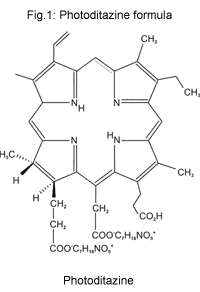Biological Evaluation Of Water-Soluble Chlorin E6 Complex "Photodithazine"
A.V.Ivanov1, L.M.Mikhailova1, G.V.Ponomarev2, V.I.Shvets3, A.T.Gradyushko1, T.N.Guseva-Donskaya4, A.V.Reshetnickov2,3, O.S.Zhukova1, N.P.Ermakova1, V.P.Laptev1, N.G.Panferova1, A.N.Leontyev1, R.E.Kokhanovsky1.
1 - N.N.Blokhin Cancer
Research Center of Russian Academy of Medical Sciences, Moscow;
2 - Institute of Biomedical Chemistry of Russian Academy of
Medical Sciences, Moscow;
3 - M. V.Lomonosov 1 Moscow Stale Academy of Fine Chemical
Technology, Russia
4 - "VETA" JSC Limited, Moscow, Russia
 A
novel stable water-soluble form of well known photosensitiser chlorin
E6 has been obtained from Spirulina Platensis algae as a complex with a
specific ligand*, and its biological characteristics evaluated.
Cytophototoxic properties (as determined in vitro by ═þ
supression of 3H-thymidine insertion in the cellular DNA) have been
ascertained using CaOv (human ovary carcinoma) cell line and
650-900 nm light at a dose of 1.5 J/cm2 with
phthalocyanine "Photosense" as a reference and proved to be as follows.
A
novel stable water-soluble form of well known photosensitiser chlorin
E6 has been obtained from Spirulina Platensis algae as a complex with a
specific ligand*, and its biological characteristics evaluated.
Cytophototoxic properties (as determined in vitro by ═þ
supression of 3H-thymidine insertion in the cellular DNA) have been
ascertained using CaOv (human ovary carcinoma) cell line and
650-900 nm light at a dose of 1.5 J/cm2 with
phthalocyanine "Photosense" as a reference and proved to be as follows.CE50 was 1 mM for "Photodithazine" and 50 mM for "Photosense", dark-toxicity being 17.2% supression for the former and 9.2% - for the latter at concentration 10 mM. In vivo acute toxicity (mice Fl {CBA x C57BI/6t}) following ex tempore 1% aqueous solution i.v. injection has been found to be 170 mg/kg for LD10, 175 mg/kg for LD16, 197 mg/kg for LD50, 220 mg/kg for LD84. Pharmacokinetics and biodistribution studies have been done using the same mice bearing innoculated in the flanks T36 embryocarcinome injected i.v. with 40 mg/kg dose of the drug. Maximal tumour and most organs' uptake was attained 1 h p.i, however, the drug's level in the organs rapidly decreasing to zero (generally by 24 h p.i.) with the best tumour/muscle ratios over 10 in 5 h p.i. "Photodithazine" is found to possess rapid clearance from the organism: 94% elimination 24 h p.i., and 98% - 48 h p.i. Optimally, light in this case is to be delivered 4-7 h p.i. PDT has been performed in vivo involving 21-23 g A/Snell mice with the same type 0.9-1 g tumours injected 40 mg/kg drug i.p., with 670 nm light being delivered 5-6 h p.i. at different doses (30-210 J/cm2). The best irradiation dose is found to be 170 J/cm2 with a sound necrotic effect and 3 week remission. At present "Photodithazine" PDT protocol is being further specified.
The authors would like to thank V.V. Ashmarov and R.Ph. Baum ("VETA" JSC Limited) for "Photodithazine" substance.
